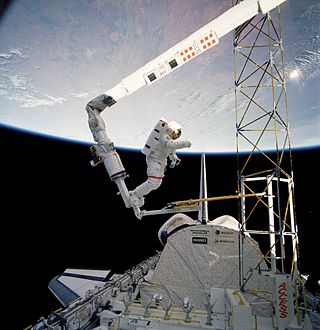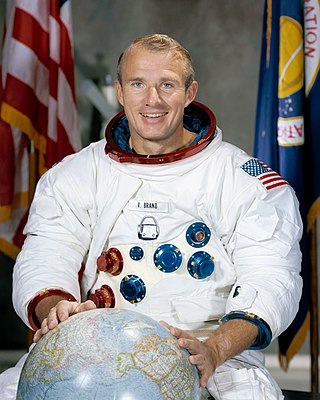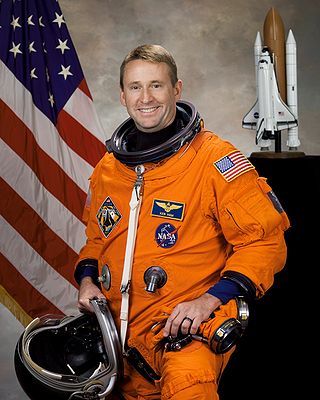
Alamogordo is the seat of Otero County, New Mexico, United States. A city in the Tularosa Basin of the Chihuahuan Desert, it is bordered on the east by the Sacramento Mountains and to the west by Holloman Air Force Base. The population was 31,384 as of the 2020 census. Alamogordo is widely known for its connection with the 1945 Trinity test, which was the first ever explosion of an atomic bomb.

Ham, a chimpanzee also known as Ham the Chimp and Ham the Astrochimp, was the first great ape launched into space. On January 31, 1961, Ham flew a suborbital flight on the Mercury-Redstone 2 mission, part of the U.S. space program's Project Mercury.

Colonel John Paul Stapp, M.D., Ph.D., was an American career U.S. Air Force officer, flight surgeon, physician, biophysicist, and pioneer in studying the effects of acceleration forces on humans. He was a colleague and contemporary of Chuck Yeager, and became known as "the fastest man on earth". His work on Project Manhigh pioneered many developments for the US space program.

STS-61-B was the 23rd NASA Space Shuttle mission, and its second using Space Shuttle Atlantis. The shuttle was launched from Kennedy Space Center, Florida, on November 26, 1985. During STS-61-B, the shuttle crew deployed three communications satellites, and tested techniques of constructing structures in orbit. Atlantis landed at Edwards Air Force Base, California, at 16:33:49 EST on December 3, 1985, after 6 days, 21 hours, 4 minutes, and 49 seconds in orbit.

The Congressional Space Medal of Honor was authorized by the United States Congress in 1969 to recognize "any astronaut who in the performance of his or her duties has distinguished himself or herself by exceptionally meritorious efforts and contributions to the welfare of the Nation and mankind". It's awarded by the President of the United States in Congress's name on recommendations from the Administrator of the National Aeronautics and Space Administration. The award is a separate decoration from the Medal of Honor, which is a military award for extreme bravery and gallantry in combat.

William McMichael "Bill" Shepherd, , is an American former Navy SEAL, aerospace, ocean, and mechanical engineer, and NASA astronaut, who served as commander of Expedition 1, the first crew on the International Space Station. He is a recipient of the Congressional Space Medal of Honor.

Vance DeVoe Brand is an American naval officer, aviator, aeronautical engineer, test pilot, and NASA astronaut. He served as command module pilot during the first U.S.-Soviet joint spaceflight in 1975, and as commander of three Space Shuttle missions.

Cosmosphere is a space museum and STEM education center in Hutchinson, Kansas, United States. It was previously known as the Kansas Cosmosphere. The museum houses over 13,000 spaceflight artifacts—the largest combined collection of US and Russian spaceflight artifacts in the world—and is home to internationally acclaimed educational programs.

George Driver "Pinky" Nelson is an American physicist, astronomer, science educator, and retired NASA astronaut.

Sidney McNeill Gutierrez, is an American pilot and former NASA astronaut. Since retiring from NASA, Gutierrez has worked in several leadership positions at Sandia National Laboratories and Rocket Crafters Inc.

The U.S. Space & Rocket Center in Huntsville, Alabama is a museum operated by the government of Alabama, showcasing rockets, achievements, and artifacts of the U.S. space program. Sometimes billed as "Earth's largest space museum", astronaut Owen Garriott described the place as, "a great way to learn about space in a town that has embraced the space program from the very beginning."

Kenneth Todd "Hock" Ham is a retired American astronaut and a captain in the United States Navy. Ham was selected for NASA's astronaut program in August 1998, while serving as the F/A-18E/F Super Hornet lead carrier suitability test pilot. Ham's aviator call sign is "Hock". Ham traveled to space twice as part of the Space Shuttle program. He flew on STS-124 as pilot and then on STS-132 as mission commander.

The Kennedy Space Center Visitor Complex is the visitor center at NASA's Kennedy Space Center on Merritt Island, Florida. It features exhibits and displays, historic spacecraft and memorabilia, shows, two IMAX theaters, and a range of bus tours of the spaceport. The "Space Shuttle Atlantis" exhibit contains the Atlantis orbiter and the Shuttle Launch Experience, a simulated ride into space. The center also provides astronaut training experiences, including a multi-axial chair and Mars Base simulator. The visitor complex also has daily presentations from a veteran NASA astronaut. A bus tour, included with admission, encompasses the separate Apollo/Saturn V Center. There were 1.7 million visitors to the visitor complex in 2016.

Space Camp is an educational camp in Huntsville, Alabama, on the grounds of the U.S. Space & Rocket Center museum near NASA's Marshall Space Flight Center. It provides residential and educational programs for children and adults on topics such as space exploration, aviation, and robotics. The camp is run by a state government agency, the Alabama Space Science Exhibit Commission. More than 900,000 campers have graduated since 1982, including several who became astronauts.

The Armstrong Air & Space Museum is a museum in Wapakoneta, Ohio, the hometown of aviator and astronaut Neil Armstrong, the first man to set foot on the Moon. Opened in 1972, the museum chronicles Ohio's contributions to the history of aeronautics and space flight. The museum is home to the original Gemini 8 spacecraft piloted by Armstrong to perform the world's first space docking, two of Armstrong's space suits, multiple items from the Apollo Program missions, a Moon rock brought back during the Apollo 11 mission, and an F5D Skylancer. The museum has several main galleries that cover the early beginnings of the Space Race, all the way to the end of the Space Shuttle Era. In the museum's Astro-theater, multimedia presentations and documentaries are cast upon the interior of the dome.

The Houston Museum of Natural Science is a natural history museum located on the northern border of Hermann Park in Houston, Texas, United States. The museum was established in 1909 by the Houston Museum and Scientific Society, an organization whose goals were to provide a free institution for the people of Houston focusing on education and science. The museum complex consists of a central facility with four floors of natural science halls and exhibits, the Burke Baker Planetarium, the Cockrell Butterfly Center, and the Wortham Giant Screen Theatre. In 2022 the museum received 1,520,000 visitors, making it seventh on the List of most-visited museums in the United States, and was the third most-visited U.S. science museum. Much of the museum's popularity is attributed to its large number of special or guest exhibits.

The United States Astronaut Hall of Fame, located inside the Kennedy Space Center Visitor Complex Heroes & Legends building on Merritt Island, Florida, honors American astronauts and features the world's largest collection of their personal memorabilia, focusing on those astronauts who have been inducted into the Hall. Exhibits include Wally Schirra's Sigma 7 space capsule from the fifth crewed Mercury mission and the Gemini IX spacecraft flown by Gene Cernan and Thomas P. Stafford in 1966.

The American Space Museum is a museum in Titusville, Florida. It includes the US Space Walk of Fame, an outdoor plaza on the Indian River that honors both the astronauts and the NASA and contractor personnel who made American crewed space exploration possible. The monuments surround a pool and are dedicated to the Mercury, Gemini, Apollo and Space Shuttle programs. The museum houses related exhibits and artifacts and is located at 308 Pine Street.
James Lawson Neihouse is an American cinematographer who has been involved with many of the most memorable and successful IMAX 2D and IMAX 3D films to date.






















